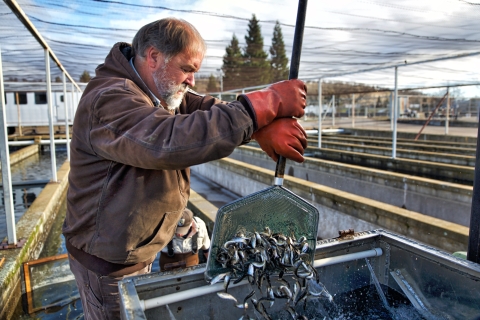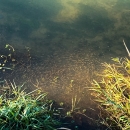Juvenile Salmonid Survival Studies
The Lodi Fish and Wildlife Office participates in large-scale, multi-agency, juvenile salmonid survival studies across California’s Central Valley, the Sacramento-San Joaquin River Delta and the San Francisco Estuary. Presently we are collaborating on projects tracking the survival and migration patterns of juvenile Chinook salmon from the Sacramento River basin through the north Delta, and tracking juvenile steelhead from the San Joaquin River basin through the south Delta.
These projects utilize acoustic telemetry to monitor and track individual fish after they are released. Fish are surgically implanted with a small acoustic tag that sends out signals, which are detected by receivers located within the Sacramento and San Joaquin rivers, the Delta and the San Francisco Estuary. Each tag has a unique code, that enables us to monitor and track the status of individual fish as they migrate to the ocean. Our office is actively participating with partner agencies to tag and release juvenile salmonids throughout the Central Valley.
Our Partners
Our office participates in collaborative projects with federal partners including the Bureau of Reclamation, National Marine Fisheries Service and U.S. Geological Survey; state partners including the California Department of Water Resources and Department of Fish and Wildlife; and universities such as the University of California, Santa Cruz, and UC, Davis. Additionally we are active members in the Interagency Telemetry Advisory Group to coordinate tagging projects and maintenance of an acoustic receiver array consisting of both real-time receivers that transmit data each hour and autonomous receivers (which are deployed to collect and store data for an entire field season) to track tagged fish throughout the Central Valley.
Our office has been using acoustic telemetry methods to track survival and migration of juvenile salmonids since the mid-2000s and have worked with various partners that assisted with the analyses, including the University of Washington and U.S. Geological Survey. Typical analyses for this type of data uses multi-state mark-recapture models to estimate reach and route survival through the Delta. The multi-state models allow us to separate the migration corridor into multiple reaches and routes (i.e., states) to assess various hypotheses on juvenile salmonid survival in the Delta and for identifying reaches of high relative mortality.
We have also partnered with the National Marine Fisheries Service and the California Department of Water Resources to evaluate predator control and relative predator mortality in the Delta. This information is used to inform managers and to recommend management actions to improve juvenile salmon and steelhead survival as they migrate through the Sacramento-San Joaquin River Delta.
Articles and Reports
Prior to using acoustic telemetry, we used coded-wire-tags to mark fish and have recovered them in sampling downstream and in the ocean fishery to estimate survival through the Delta. We have published several peer-reviewed journal articles, newsletter articles and agency reports with our partners, many of which can be viewed at the links below. For more information or reports, email bryan_matthias@fws.gov.
Peer-Reviewed Journal Articles
Six-Year Acoustic Telemetry Steelhead Study: Statistical Methods and Results
NMFS Biological Opinion RPA Six-Year Acoustic Telemetry Steelhead Study
Methods and Implementation of Steelhead Tagging and Results
San Joaquin River Group Authority Annual Technical Reports on Implementation and Monitoring of the San Joaquin River Agreement and the Vernalis Adaptive Management Plan



